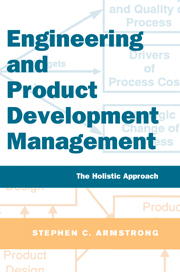Book contents
- Frontmatter
- Contents
- List of figures and tables
- Forewords
- Preface
- Acknowledgments
- Layout of book at a glance
- PART 1 UNDERSTANDING ENGINEERING PROCESS MANAGEMENT
- PART 2 APPLYING ENGINEERING PROCESSES TO PROGRAM MANAGEMENT
- 4 Roles and responsibilities
- 5 Approach to program and project management
- 6 An integrated team member's guide to performing a task
- 7 Program structuring and planning
- 8 Risk assessment
- 9 Program initiation and execution
- 10 Program reviews
- 11 Engineering change management and product data management
- PART 3 DEPLOYING ENGINEERING PROCESS MANAGEMENT
- PART 4 APPENDIXES
- Glossary
- References
- Index
4 - Roles and responsibilities
Published online by Cambridge University Press: 05 April 2014
- Frontmatter
- Contents
- List of figures and tables
- Forewords
- Preface
- Acknowledgments
- Layout of book at a glance
- PART 1 UNDERSTANDING ENGINEERING PROCESS MANAGEMENT
- PART 2 APPLYING ENGINEERING PROCESSES TO PROGRAM MANAGEMENT
- 4 Roles and responsibilities
- 5 Approach to program and project management
- 6 An integrated team member's guide to performing a task
- 7 Program structuring and planning
- 8 Risk assessment
- 9 Program initiation and execution
- 10 Program reviews
- 11 Engineering change management and product data management
- PART 3 DEPLOYING ENGINEERING PROCESS MANAGEMENT
- PART 4 APPENDIXES
- Glossary
- References
- Index
Summary
The successful implementation of an advanced engineering program is a team effort. To be effective, the program team must be more than just a collection of individuals. The team must have the management, technical, functional, and product skills necessary to address the variety of challenges typically encountered on an advanced engineering program. Moreover, your company's partners and subcontractors must work well together to provide an effective solution for the customer.
As organizations growlarger, hierarchical structures, specialization, and facility dispersion make it more difficult to communicate across functional boundaries and to coordinate activities. Integrated product teams are a way to organize into smaller units to facilitate communication among customer, suppliers, partners, and your company; to develop a multifunctional perspective; and to develop wellbalanced, consensus decision making.
The organization of the team members on the program is a critical aspect of the proposal and program initiation processes. Before the program can get under way, it is necessary to identify the major program roles and responsibilities. Individuals should then be selected to fill those roles based on their skills and experience in solving similar problems.
Customer personnel, operational/program management, and partners play specific roles in the management and execution of an engineering program. The organization for a specific program depends on the product design, the particular program responsibilities of your company, customer and partners, and other program characteristics. However, certain roles are common to every program.
- Type
- Chapter
- Information
- Engineering and Product Development ManagementThe Holistic Approach, pp. 51 - 75Publisher: Cambridge University PressPrint publication year: 2001



